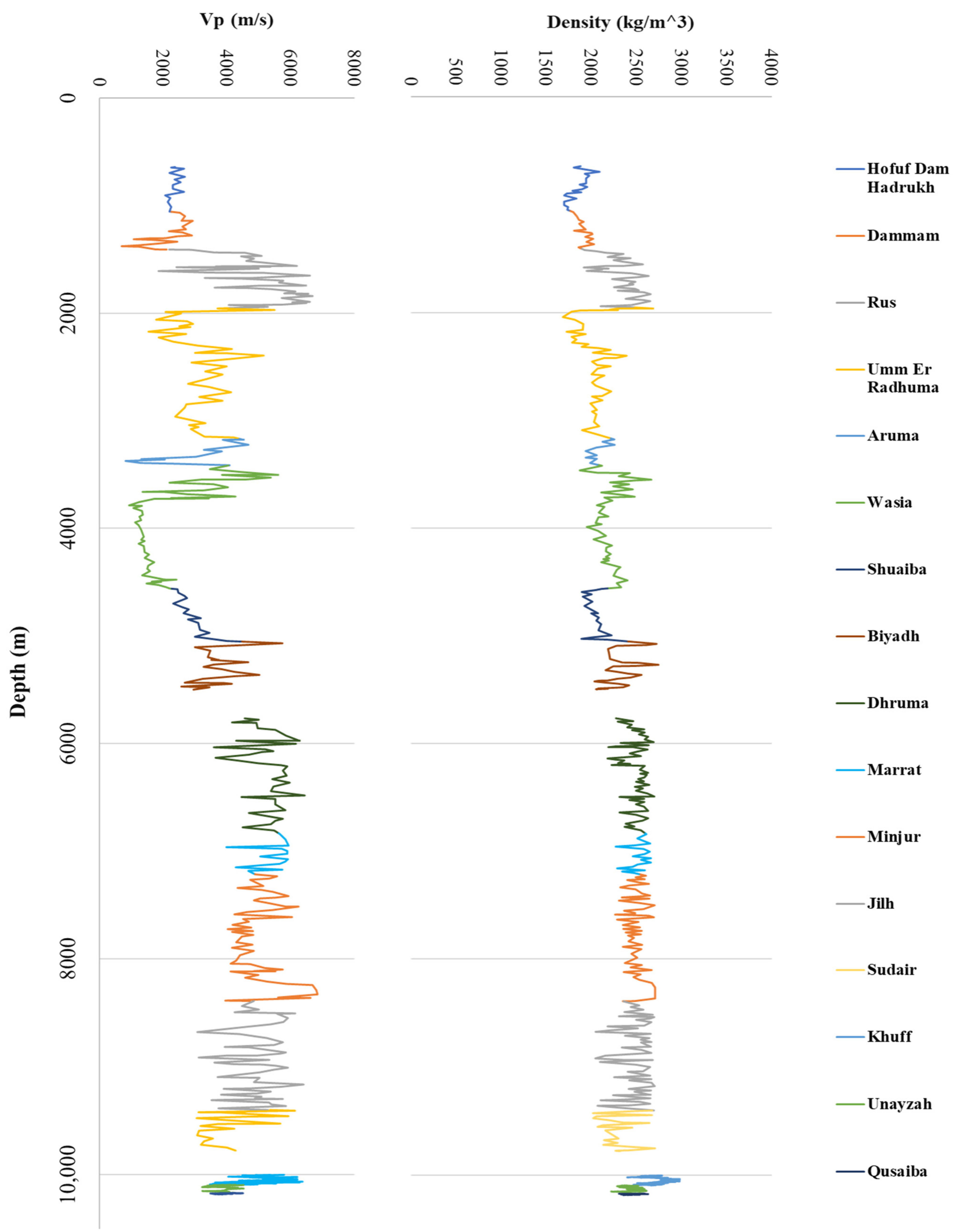Viscoelastic Model and Synthetic Seismic Data of Eastern Rub’Al-Khali
Abstract
1. Introduction
2. Geology of the Rub’ Al-Khali Basin
3. Development of Digital Depth Models
4. The Synthetic Seismic Data Generation Procedure
5. Conclusions
Author Contributions
Funding
Institutional Review Board Statement
Informed Consent Statement
Data Availability Statement
Acknowledgments
Conflicts of Interest
References
- Li, Q.; Wu, G.; Wu, J.; Duan, P. Finite difference seismic forward modeling method for fluid–solid coupled media with irregular seabed interface. J. Geophys. Eng. 2019, 16, 198–214. [Google Scholar] [CrossRef]
- Wang, J.; Hong, L. Stable optimization of finite-difference operators for seismic wave modeling. Studia Geophys. Geod. 2020, 64, 452–464. [Google Scholar] [CrossRef]
- Liu, J.; Yong, W.A.; Liu, J.; Guo, Z. Stable Finite-Difference Methods for Elastic Wave Modeling with Characteristic Boundary Conditions. Mathematics 2020, 8, 1039. [Google Scholar] [CrossRef]
- Wang, Y.; Ning, Y.; Wang, Y. Fractional Time Derivative Seismic Wave Equation Modeling for Natural Gas Hydrate. Energies 2020, 13, 5901. [Google Scholar] [CrossRef]
- Maranzoni, A.; Mignosa, P. Seismic-generated unsteady motions in shallow basins and channels. Part II: Numerical modelling. Appl. Math. Model. 2019, 68, 712–731. [Google Scholar] [CrossRef]
- Xu, Y.; Chen, X.; Han, D.; Zhang, W. Complex topography and media implementation using hp-adaptive DG-FEM for seismic wave modeling. EGU General Assembly 2020, Lund, Sweden, Online, 4–8 May 2020, EGU2020-21047. Available online: https://meetingorganizer.copernicus.org/EGU2020/EGU2020-21047.html (accessed on 1 June 2020).
- Asfour, K.; Martin, R.; El Baz, D. Numerical Modeling of Attenuation and Nonlinear Effects in Computational Seismology. EGU General Assembly Conference Abstracts. 2020, p. 91. Available online: https://ui.adsabs.harvard.edu/abs/2020EGUGA..22...91A/abstract (accessed on 1 June 2020).
- Jiang, C.; Zhou, H.; Xia, M.; Chen, H.; Zhang, Y.; Jiang, S. Acoustic Wave Simulation by Lattice Boltzmann Method with D2Q5 and D2Q9 of Different Relaxation Times. In Proceedings of the 81st EAGE Conference and Exhibition, London, UK, 3–6 June 2019; European Association of Geoscientists & Engineers: Houten, The Netherlands, 2019; pp. 1–5. [Google Scholar] [CrossRef]
- Sakemi, Y.; Hitoshi Mikada, J.T. A quantitative analysis of the passive seismic emission tomography using the lattice Boltzmann method. In Proceedings of the Japan Geoscience Union Meeting, Chiba, Japan, 26–30 May 2019; p. STT42–P04. [Google Scholar]
- Mora, P.; Morra, G.; Yuen, D.A. A concise python implementation of the lattice Boltzmann method on HPC for geo-fluid flow. Geophys. J. Int. 2020, 220, 682–702. [Google Scholar]
- Khan, S.; Khulief, Y.A.; Al-Shuhail, A. Mitigating climate change via CO2 sequestration into Biyadh reservoir: Geomechanical modeling and caprock integrity. Mitig. Adapt. Strateg. Glob. Chang. 2019, 24, 23–52. [Google Scholar] [CrossRef]
- Khan, S.; Al-Shuhail, A.; Khulief, Y.A. Numerical modeling of the geomechanical behavior of Ghawar Arab-D carbonate petroleum reservoir undergoing CO2 injection. Environ. Earth Sci. 2016, 75, 1499. [Google Scholar] [CrossRef]
- Khan, S.; Khulief, Y.A.; Al-Shuhail, A. The effect of injection well arrangement on CO2 injection into carbonate petroleum reservoir. Int. J. Glob. Warm. 2018, 14, 462–487. [Google Scholar] [CrossRef]
- Khan, S.; Khulief, Y.A.; Al-Shuhail, A. Numerical modeling of the geomechanical behavior of Biyadh reservoir undergoing CO2 injection. Int. J. Geomech. 2017, 17, 04017039. [Google Scholar] [CrossRef]
- Carcione, J.; Poletto, F.; Farina, B.; Craglietto, A. Simulation of seismic waves at the earth’s crust (brittle-ductile transition) based on the Burgers model. Solid Earth 2014, 5, 1001. [Google Scholar] [CrossRef]
- Soliman, F.; Al Shamlan, A. Review on the geology of the Cretaceous sediments of the Rub’al-Khali, Saudi Arabia. Cretac. Res. 1982, 3, 187–194. [Google Scholar] [CrossRef]
- Nairn, A.; Alsharhan, A. Sedimentary Basins and Petroleum Geology of the Middle East; Elsevier: Amsterdam, The Netherlands, 1997. [Google Scholar]
- Alfara, M.N.; Nebrija, E.L.; Ferguson, M.D. The Challenge of Interpreting 3-D Seismic in Shaybah Field, Saudi Arabia. GeoArabia 1998, 3, 209–226. [Google Scholar]
- Stewart, S.; Reid, C.; Hooker, N.; Kharouf, O. Mesozoic siliciclastic reservoirs and petroleum system in the Rub’Al-Khali basin, Saudi Arabia. Aapg Bull. 2016, 100, 819–841. [Google Scholar]
- Stewart, S. Structural geology of the Rub’Al-Khali Basin, Saudi Arabia. Tectonics 2016, 35, 2417–2438. [Google Scholar] [CrossRef]
- Al-Shuhail, A.A.; Mousa, W.A.; Alkhalifah, T. KFUPM-KAUST Red Sea model: Digital viscoelastic depth model and synthetic seismic data set. Lead. Edge 2017, 36, 507–511. [Google Scholar] [CrossRef]
- Al-Shuhail, A.A.; Alshuhail, A.A.; Khulief, Y.A.; Salam, S.A.; Chan, S.A.; Ashadi, A.L.; Al-Lehyani, A.F.; Almubarak, A.M.; Khan, M.Z.U.; Khan, S.; et al. KFUPM Ghawar digital viscoelastic seismic model. Arab. J. Geosci. 2019, 12, 245. [Google Scholar] [CrossRef]
- Khan, A.M.; Al-Juhani, S.G.; Abdul, S. Digital Viscoelastic Seismic Models and Data Sets Of Central Saudi Arabia in the Presence of Near-Surface Karst Features. J. Seism. Explor. 2020, 29, 15–28. [Google Scholar]
- Zhou, H.W. Multi-scale tomography for crustal P and S velocities in southern California. Pure Appl. Geophys. 2004, 161, 283–302. [Google Scholar] [CrossRef]
- Pollastro, R.M. Total Petroleum Systems of the Paleozoic and Jurassic, Greater Ghawar Uplift and Adjoining Provinces of Central Saudi Arabia and Northern Arabian-Persian Gulf; US Geological Survey; US Department of the Interior: Washington, DC, USA, 2003; p. 2202-H.
- Ameen, M.S.; Smart, B.G.; Somerville, J.M.; Hammilton, S.; Naji, N.A. Predicting rock mechanical properties of carbonates from wireline logs (A case study: Arab-D reservoir, Ghawar field, Saudi Arabia). Mar. Pet. Geol. 2009, 26, 430–444. [Google Scholar] [CrossRef]
- Mittet, R. A simple design procedure for depth extrapolation operators that compensate for absorption and dispersion. Geophysics 2007, 72, S105–S112. [Google Scholar] [CrossRef]
- Bridle, R.; Ley, R.; Al-Mustafa, A. Near-surface models in Saudi Arabia. Geophys. Prospect. 2007, 55, 779–792. [Google Scholar] [CrossRef]
- Liu, L.; Kharji, M.; Chatterjee, H.S. Seismic attributes as exploration tools: A case study from the Jurassic in Saudi Arabia. In Proceedings of the IPTC 2013: International Petroleum Technology Conference, Beijing, China, 26–28 March 2013; European Association of Geoscientists & Engineers: Houten, The Netherlands, 2013; p. cp–350. [Google Scholar]
- Dasgupta, S.N.; Hong, M.R.; La Croix, P.; Al-Mana, L.; Robinson, G. Prediction of reservoir properties by integration of seismic stochastic inversion and coherency attributes in super Giant Ghawar field. In SEG Technical Program Expanded Abstracts 2000; Society of Exploration Geophysicists: Tulsa, OK, USA, 2000; pp. 1501–1505. [Google Scholar]
- Macrides, C.G.; Kelamis, P.G. A 9C-2D land seismic experiment for lithology estimation of a Permian clastic reservoir. GeoArabia 2000, 5, 427–440. [Google Scholar]
- Al-Ahmadi, M.E. Hydrogeology of the Saq aquifer northwest of Tabuk, northern Saudi Arabia. Earth Sci. 2009, 20, 15. [Google Scholar] [CrossRef]
- Mooney, W.D.; Gettings, M.E.; Blank, H.R.; Healy, J.H. Saudi Arabian seismic-refraction profile: A traveltime interpretation of crustal and upper mantle structure. Tectonophysics 1985, 111, 173–246. [Google Scholar] [CrossRef]
- Sharland, P.; Archer, R.; Davies, R.B.; Simmons, M.D.; Sutcliffe, O.E. Arabian Plate Sequence Stratigraphy; GeoArabia Special Publication: Tysons, VA, USA, 2001; Volume 2, p. 371. [Google Scholar]
- Robertsson, J.O.; Blanch, J.O.; Symes, W.W. Viscoelastic finite-difference modeling. Geophysics 1994, 59, 1444–1456. [Google Scholar] [CrossRef]
- Talukdar, K.; Behera, L. Sub-basalt Imaging of Hydrocarbon-Bearing Mesozoic Sediments Using Ray-Trace Inversion of First-Arrival Seismic Data and Elastic Finite-Difference Full-Wave Modeling Along Sinor–Valod Profile of Deccan Syneclise, India. Pure Appl. Geophys. 2018, 175, 2931–2954. [Google Scholar] [CrossRef]
- Thorbecke, J. Finite-Difference Wavefield Modeling; 2016. [Google Scholar]


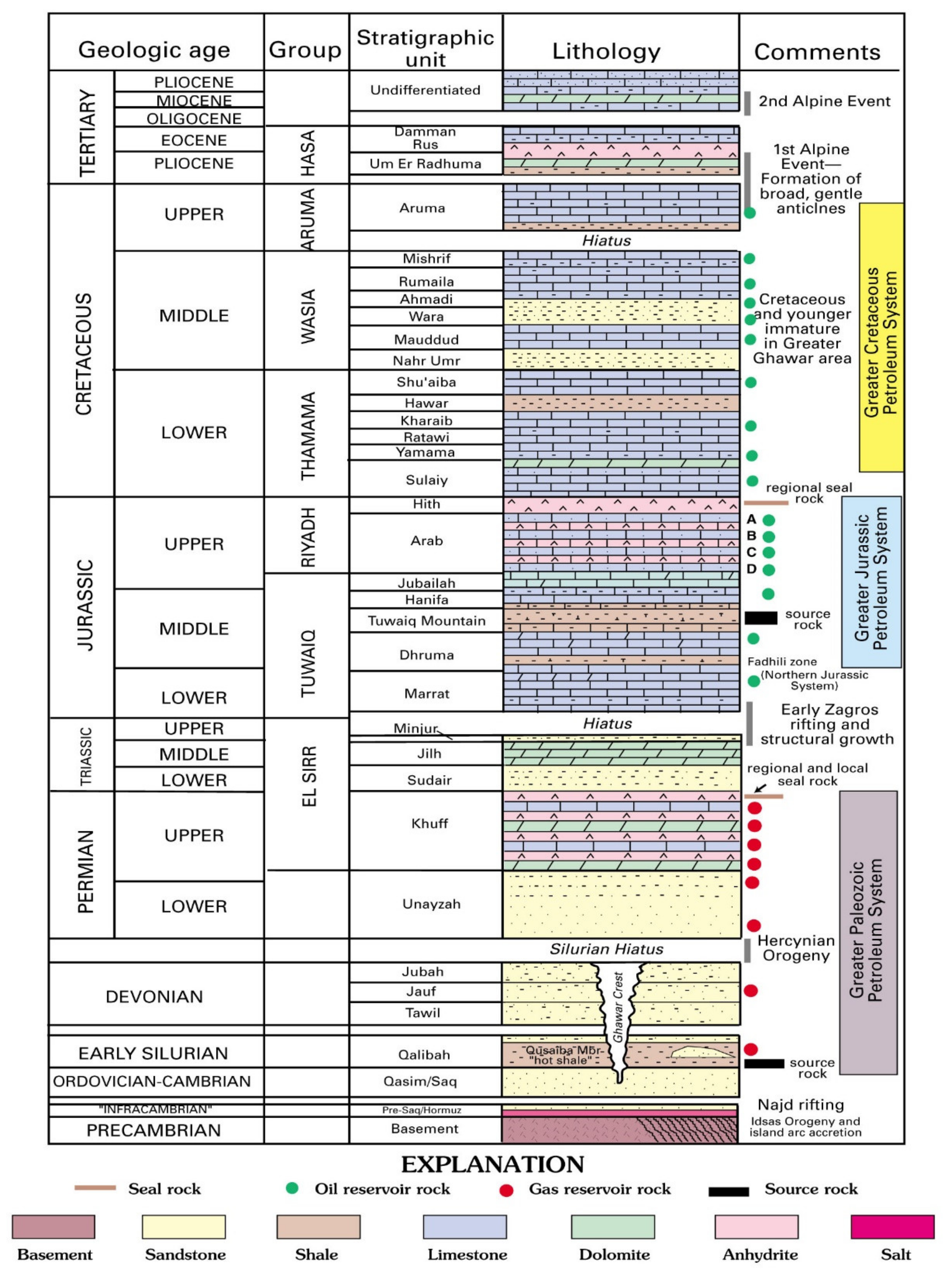
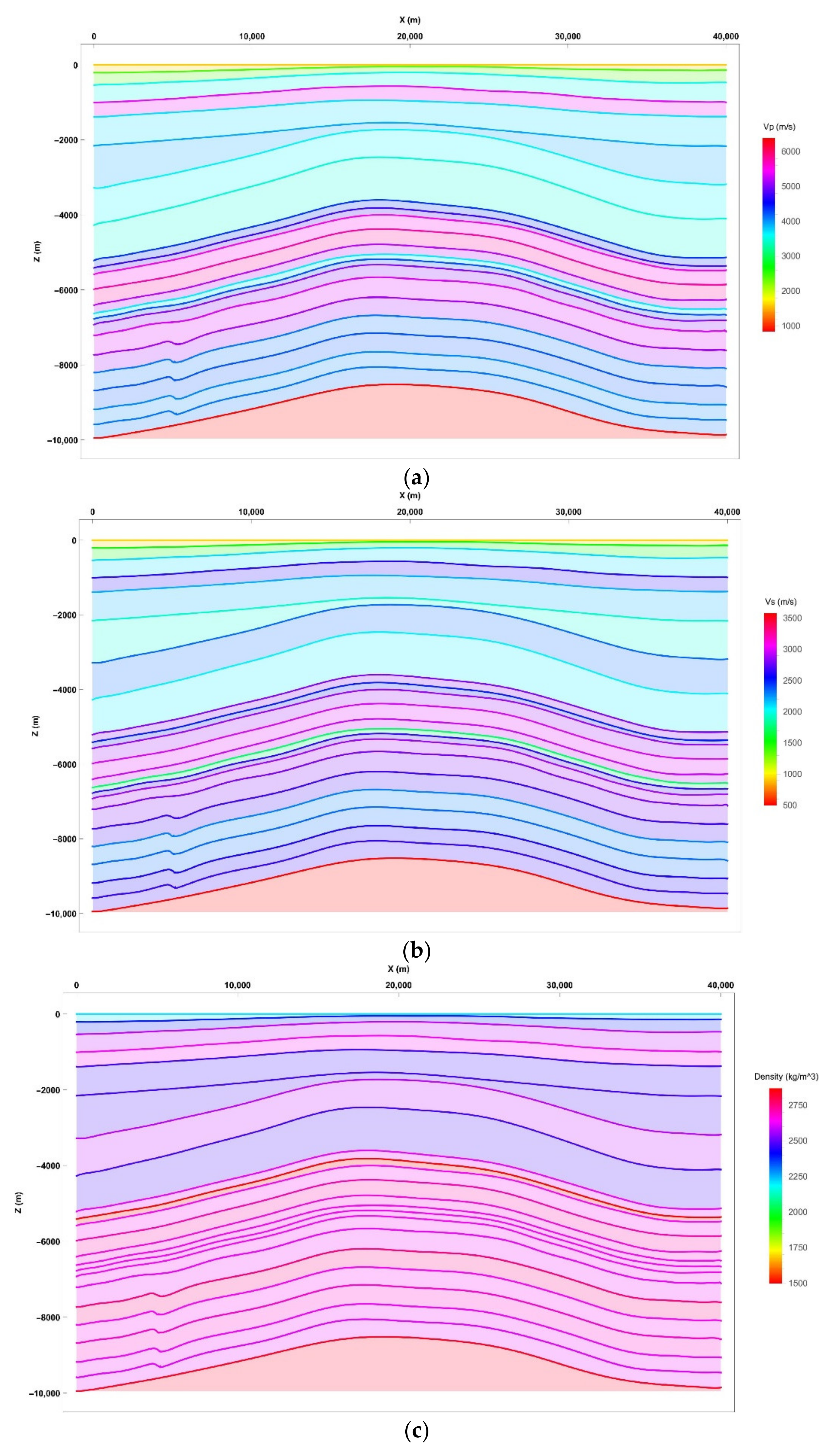
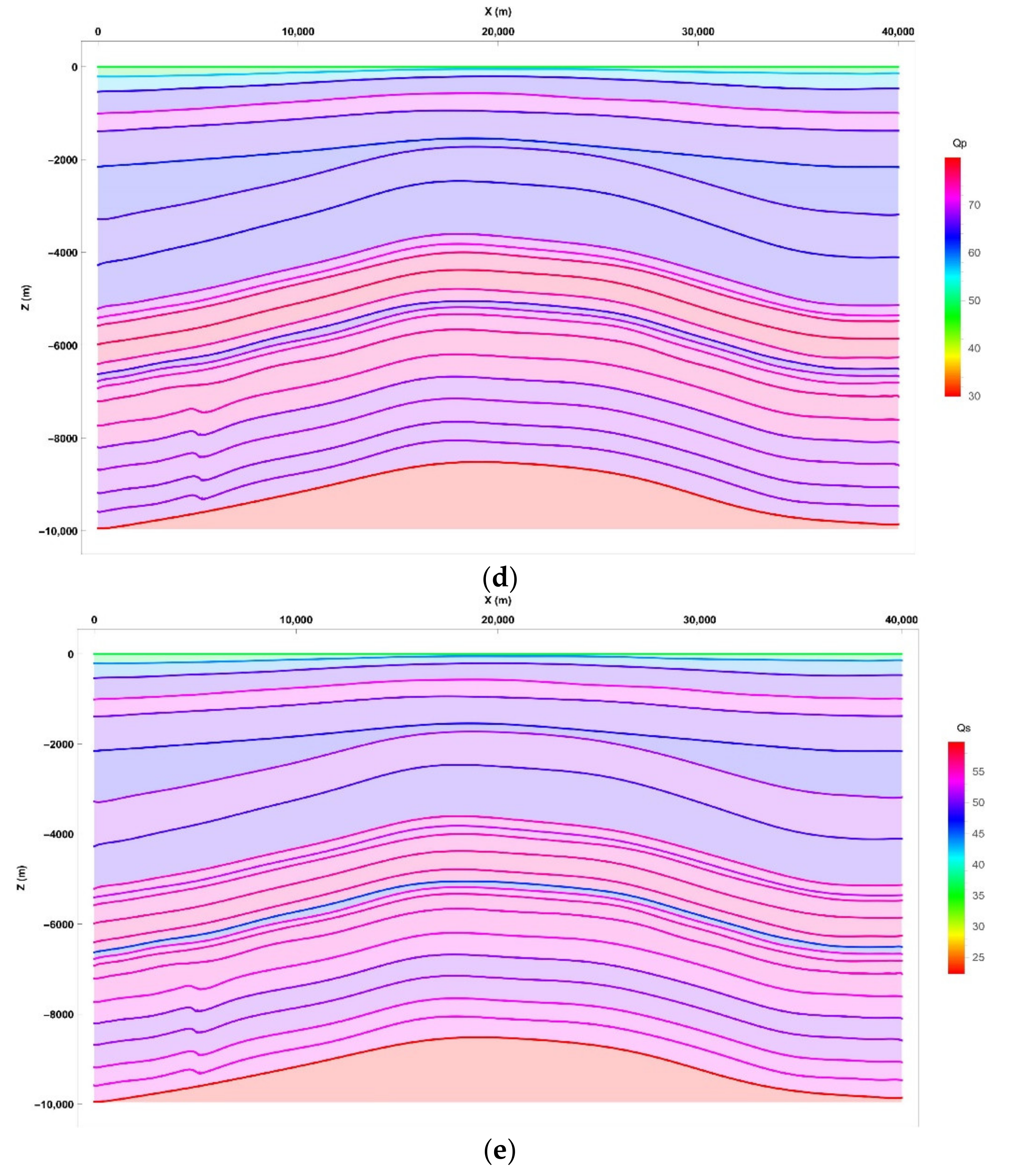

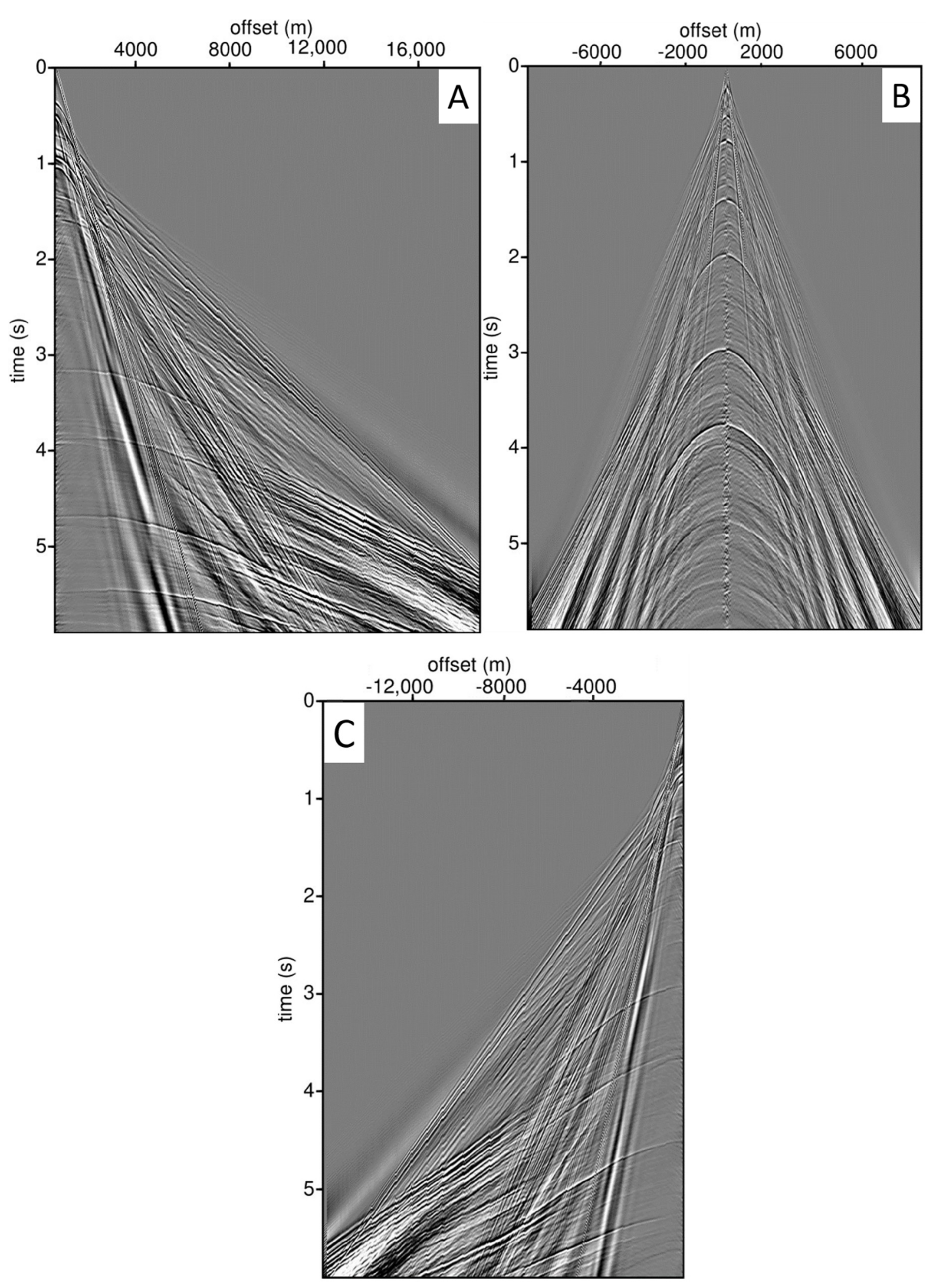
| Layer | Formation | Lithology | ρ (kg/m3) | Vp (m/s) | Vs (m/s) | Qp | Qs |
|---|---|---|---|---|---|---|---|
| F-1 | Quaternary | Sand | 1500 a | 850 a | 501 a | 29.15 i | 22.36 i |
| F-2 | Hofuf Dam Hadrukh | Mixed limestone and siliciclastic | 1877 b | 1835 b | 1180 c | 42.84 i | 34.35 i |
| F-3 | Dammam | Limestone | 2289 b | 3110 b | 1870 d | 55.77 i | 43.24 i |
| F-4 | Rus | Anhydrite | 2397 b | 5252 b | 2470 d | 65.32 i | 49.70 i |
| F-5 | Umm Er Radhuma | Limestone | 2028 b | 3318 b | 1978 d | 57.60 i | 44.47 i |
| F-6 | Aruma | Limestone | 2037 b | 3558 b | 1672 d | 52.25 i | 40.89 i |
| F-7 | Wasia | Sandstone | 2277 b | 3233 b | 2142 c | 56.86 i | 46.28 i |
| F-8 | Shuaiba | Limestone | 2037 b | 3010 b | 1818 d | 54.86 i | 42.63 i |
| F-9 | Biyadh | Sandstone | 2364 b | 4045 b | 2701 c | 63.60 i | 51.97 i |
| F-10 | Hith | Anhydrite | 2874 e | 4483 e | 2328 e | 66.96 i | 48.24 i |
| F-11 | Arab | Limestone | 2400 e | 5399 e | 2748 e | 73.47 i | 52.42 i |
| F-12 | Hanifa & Tuwaiq Mountain | Limestone | 2550 | 5698 e,k | 2903 e | 75.48 i | 53.88 i |
| F-13 | Dhruma | Limestone | 2458 f,k | 5033 f,k | 2870 d | 70.94 i | 53.57 i |
| F-14 | Marrat | Shale | 2410 f | 3272 f | 1436 c | 57.20 i | 37.89 i |
| F-15 | Minjur | Sandstone | 2394 f | 3930 f | 2499 c | 62.69 i | 49.99 i |
| F-16 | Jilh | Dolomite | 2400 f,k | 4823 f,k | 2761 d | 69.45 i | 52.54 i |
| F-17 | Sudair | Shale | 2372 g,k | 5182 g,k | 2674 g | 71.99 i | 51.71 i |
| F-18 | Khuff | Dolomite | 2639 g,k | 4953 g,k | 2530 g | 70.38 i | 50.3 i |
| F-19 | Unayzah | Sandstone | 2405 g | 3752 g | 2085 g | 61.25 i | 45.66 i |
| F-20 | Qusaiba | Shale | 2486 g | 3898 g | 2143 g | 62.43 i | 46.29 i |
| F-21 | Qasim | Sandstone | 2380 h | 3685 h | 2453 c | 60.70 i | 49.53 i |
| F-22 | Saq | Sandstone | 2350 h | 3765 h | 2508 c | 61.36 i | 50.08 i |
| F-23 | Basement | Igneous and metamorphic | 2800 j | 6380 j | 3580 j | 79.87 i | 59.83 i |
| Parameter | Value |
|---|---|
| Source wavelet | 20 Hz zero-phase Ricker |
| Time sampling interval for finite-difference calculation | 0.14 ms |
| Square-grid size for finite-difference calculation | 1.5 m |
| Receiver spacing | 25 m |
| Shot spacing | 50 m |
| Recording time sampling interval | 4.0 ms |
| Total recording time | 6.0 s |
| Total number of receivers | 1535 |
| Receivers x-axis | 0 to 40,000 m |
| Receivers z-axis | 15 m |
| Shots x-axis | 0 to 40,000 m |
| Shots z-axis | 15 m |
| Offset range | −40,000 to 40,000 m |
| Total number of shots | 801 shots |
Publisher’s Note: MDPI stays neutral with regard to jurisdictional claims in published maps and institutional affiliations. |
© 2021 by the authors. Licensee MDPI, Basel, Switzerland. This article is an open access article distributed under the terms and conditions of the Creative Commons Attribution (CC BY) license (http://creativecommons.org/licenses/by/4.0/).
Share and Cite
Chan, S.A.; Edigbue, P.; Khan, S.; Ashadi, A.L.; Al-Shuhail, A.A. Viscoelastic Model and Synthetic Seismic Data of Eastern Rub’Al-Khali. Appl. Sci. 2021, 11, 1401. https://doi.org/10.3390/app11041401
Chan SA, Edigbue P, Khan S, Ashadi AL, Al-Shuhail AA. Viscoelastic Model and Synthetic Seismic Data of Eastern Rub’Al-Khali. Applied Sciences. 2021; 11(4):1401. https://doi.org/10.3390/app11041401
Chicago/Turabian StyleChan, Septriandi A., Paul Edigbue, Sikandar Khan, Abdul L. Ashadi, and Abdullatif A. Al-Shuhail. 2021. "Viscoelastic Model and Synthetic Seismic Data of Eastern Rub’Al-Khali" Applied Sciences 11, no. 4: 1401. https://doi.org/10.3390/app11041401
APA StyleChan, S. A., Edigbue, P., Khan, S., Ashadi, A. L., & Al-Shuhail, A. A. (2021). Viscoelastic Model and Synthetic Seismic Data of Eastern Rub’Al-Khali. Applied Sciences, 11(4), 1401. https://doi.org/10.3390/app11041401





